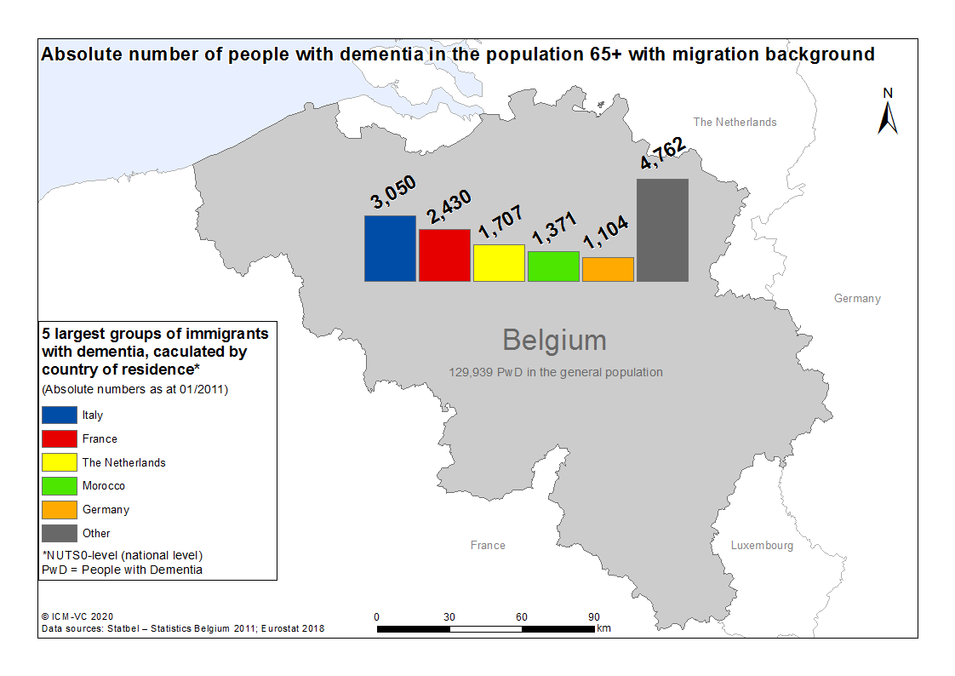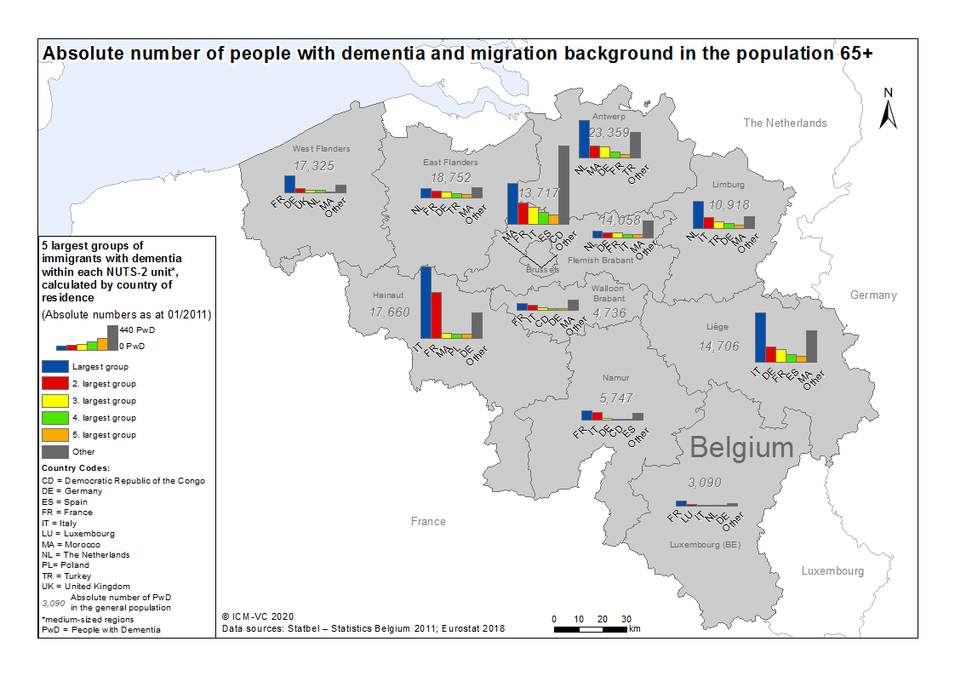EU-Atlas: Dementia & Migration
| Largest group | 2. largest group | 3. largest group | 4. largest group | 5. largest group | |
| Absolute numbers | |||||
| PwMD per 100,000 inhabitants 65+ |
| Absolute numbers | PwMD per 100,000 inhabitants 65+ | |
| Largest group | ||
| 2. largest group | ||
| 3. largest group | ||
| 4. largest group | ||
| 5. largest group |
| Prevalence per 100,000 inhabitants 65+*, calculated by country of residence | |||
|---|---|---|---|
| high > PwMD |
minor > - PwMD |
||
| increased > - PwMD |
low ≤ PwMD | ||
| medium > - PwMD |
|||
| PwMD = People with a Migration background with Dementia *Bulgarien, Litauen, Malta, Polen in der Bevölkerung 60+ |
|||
| Absolute number of PwMD 65+ | |
| PwMD per 100,000 inhabitants 65+ |
Belgium
Belgium was an emigration country in the past. The history of immigration began during the First World War when people from neighboring countries, Eastern Europe and Italy searched for work in Belgium. After an agreement with Italy, 110,000 Italian workers arrived between 1946 and 1956. Subsequently, Belgium concluded bilateral recruitment agreements with countries such as Spain (1956), Morocco (1964), and Turkey (1964). In recent history, refugees from conflict areas, foreign students, and migrants from the new EU member states took the place of migrant workers. In 2017, migrants from Morocco were the largest migrant group with 215,000 people, followed by France (185,000), the Netherlands (130,000), and Turkey (98,000)1. Between 1990 and 2019, the migrant population (born abroad) increased from 1.3 to 2 million people2.
There are 209,000 people with a migration background aged 65 or older. Of those, approx. 14,400 are estimated to exhibit some form of dementia. Calculations show the most affected migrant groups presumably originate from Italy (approx. 3,000), France (approx. 2,400), Netherlands (approx. 1,700), Morocco (approx. 1,400), and Germany (approx. 1,100)3.
While for the southern region Wallonia no dementia plan or a document with care guidelines could be identified, the northern region Flanders has five documents on dementia care. The analysis of the Flemish dementia plan and the four guidelines on the care of people with dementia has shown that the topic of dementia and migration is becoming more important in Flanders and is also increasingly taken into account in documents on dementia care. People with a migration background with dementia are identified as a vulnerable group with specific needs to whom culturally sensitive care should be offered in the future. Currently, there seem to be major gaps in this regard4-8.
The two interviewed experts confirmed that there are large gaps in care for people with a migration background with dementia since dementia and migration is a new topic in society, politics, science, and the healthcare system, and is currently not being given any structural attention within these systems. The experts state that there are currently no specialised healthcare services for this population.
According to the interviewed experts, intercultural or culturally sensitive care is not an integral part of the professional training of health or nursing staff. The experts pointed out that there are currently some structural and social conditions in Belgium that represent a barrier to the inclusion of people with a migration background in the entire spectrum of healthcare professions.
In the experts’ opinion, there is a general problem of support and information for family caregivers of people with dementia in Belgium. This problem is even greater and more complex with regard to the relatives of people with a migration background with dementia. There are no specialised information resources enabling them to discuss the topic of dementia with their family in their mother tongue. Overall, a great need for specialised services providing support and information for the relatives of people with a migration background with dementia is evident in Belgium.
References
- Lafleur J-M, Marfouk A: A Common Home: Migration and Development in Belgium. In. Brussels: Caritas International; 2019.
- International Organization for Migration: Total number of international migrants at mid-year 2019: Belgium; 2019.
- Statistics Belgium: Census 2011; 2011.
- Vlaamse Regering: TRANSITIEPLAN ‘DEMENTIEKUNDIGE BASISZORG IN HET NATUURLIJK THUISMILIEU’. In. Edited by Volksgezondheid en Gezin; 2014.
- Vlaamse Regering: continuing to build a dementia-friendly Flanders together: updated Dementia Plan for Flanders 2016 – 2019; 2016.
- Dely H, Verschraegen J, Steyaert J: You and me, together we are human: A reference framework for quality of life, housing and care for people with dementia. Antwerpen, Belgium: European Patent Office publishing company; 2018.
- Constant O, Lamers H, Steyaert J, Verschraegen J, Dely H: Memorandum 2019. In. Antwerpen: Expertisecentrum Dementie Vlaanderen, Alzheimer Liga Vlaanderen; 2018.
- Constant O, Lamers H, Steyaert J, Verschraegen J, Wildiers P: Memorandum 2014. In. Edited by Vlaanderen ED, Liga VA. Antwerpen: Expertisecentrum Dementie Vlaanderen, Vlaamse Alzheimer Liga; 2013.



![[Translate to Englisch:] Logo RBS [Translate to Englisch:] Logo RBS](/fileadmin/_processed_/9/7/csm_RBS_Logo_RGB_0e245a98a4.jpeg)